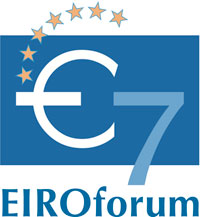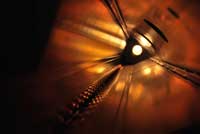Teachers and scientists face to face: the first EIROforum teacher school Inspire article
What is matter? How did the Universe begin? Are there other planets like Earth? And how do we know? Eleanor Hayes reports on the first EIROforum teacher school.

The first teacher school organised by EIROforumw1, the publisher of Science in School, saw 35 science teachers from 17 European countries flock to CERNw2 in Geneva, Switzerland, in November 2009. Over four days, the teachers were inspired, fascinated and challenged by the evolution of the Universe – what do we know and how do we know it?
The aim – which, to judge by the teachers’ feedback, was amply achieved – was to give a flavour of the science done in four of the seven EIROforum organisations, inspiring the teachers to return home and motivate their students.
Using the same formula as CERN’s long-running teacher schools (see box), the EIROforum teacher school involved lectures by EIROforum scientists on topics as varied as the structure of matter (Landua & Rau, 2008), the origin of the Solar Systemw3, the search for extra-solar planets (Fridlund, 2009) and how to build a cloud chamber at school (Barradas-Solas, 2010). Other important elements were visits to research facilities including CERN’s Large Hadron Collider (LHC; Landua, 2008) and the interaction both among the teachers and between teachers and scientists.

at CERN
Image courtesy of Paulo José
Carapito
The key point was to show the teachers what we know about the beginning and the evolution of the Universe, but also – perhaps even more importantly – how this knowledge was obtained. The lectures, by scientists from CERN, EFDA-JET, ESA and ESO, demonstrated how the scientific disciplines work together to unravel nature’s mysteries, how the research done in these four organisations focuses on finding answers to this common question.
“The lectures were very interesting and they will be very valuable in my teaching,” reported Jens Nielsen from Norway. Svejina Dimitrova from Bulgaria and Dana Jancinova from Slovakia added: “We need to update our knowledge regularly. Such courses are very useful to us and we will be able to bring our enthusiasm to our students.”
The next in the planned series of annual teacher schools will cover research from the other three EIROforum organisations: ESRF, ILL and EMBL will combine forces to bring life sciences alive at ESRF in Grenoble, France. For those European teachers lucky enough to be selected, EIROforum will cover not only the costs of their participation and accommodation but also their travel expenses to Grenoble. Teachers are selected on the basis of their motivation and enthusiasm to apply what they learn – and competition is stiff. If you’re inspired to take part, keep a close eye on the Science in School websitew4, where details of how to apply will be published.
Other education activities at the EIROforum organisations
CERN
The EIROforum teacher schools are based on CERN’s long-running physics teacher programmes, more than 20 of which are organised each year. The three-day physics teacher programmes are run in English for teachers from all over Europe, and they include seminars, visits and educational activities. The national teacher programmes are similar, but are held in the national language of the participants from CERN member states. The high-school teachers programme in summer is an international three-week course held in English. Details of all courses are available on the CERN websitew2.
EFDA-JET
The Joint European Torus (JET)w5 is Europe’s largest nuclear fusion research facility, operated under the European Fusion Development Agreement (EFDA).
Both EFDA-JET and many of the other fusion research institutes in the European Fusion Development Agreement (EFDA) have their own outreach programmes, which often include lectures, as well as visits to schools and research facilities. Details of the individual research institutes are available on the EFDA websitew6.
Educational materials, including booklets, CD-ROMs, images and movies, are available via the EFDA website. The website also provides basic and more advanced information about fusion science.
EMBL
Amongst other education activities, the European Molecular Biology Laboratory (EMBL) organises 2-3 day workshops for European secondary-school teachersw7, to introduce them to state-of-the-art molecular biology. The courses consist of lectures by EMBL scientists, practical activities suitable for schools, tours of the research facilities, and the chance to share science-teaching ideas with each other and the scientists.
ESA
The European Space Agency (ESA) offers a range of hands-on projects for schools (including a current competition to design a satellite – the ten best satellites will be launched into spacew8). Via its European Space Education Resource Offices in several countriesw9, ESA also offers support to local teachers, developing materials appropriate for the national education systems. Many more educational resources – including teaching materials, images, DVDs and much more – can be downloaded or ordered from the ESA Education websitew10. The ESA Kids’ websitew11, available in English, Dutch, French, German, Italian and Spanish, offers quizzes, pictures, animations and space-related news for children.
ESO
In support of astronomy and astrophysics education, especially at the secondary-school level, the European Southern Observatory (ESO) produces teaching material, such as education sheets about the Atacama Large Millimeter / submillimeter Array (ALMA) telescope project, which accompany the planetarium show about ALMA, ‘In search of our cosmic origins’w12. Another set of exercises, which use real data from telescopes such as the ESO Very Large Telescope, is produced in collaboration with ESAw13. ESO has also collaborated with the European Association for Astronomy Education (EAAE)w14. More information about ESO’s education and outreach activities, as well as comprehensive galleries of astronomy-related image and video material, is available on the ESO websitew15.
ESRF and ILL
To be opened in 2013, the visitors’ centre on the ESRFw16 and ILLw17 site in Grenoble, France, will introduce the general public and school students to neutron and photon science, through hands-on activities, an exhibition and tours of the research facilities.
References
- For instructions on how to build and use a cloud chamber at school, see:
- Barradas-Solas F, Alameda-Meléndez P (2010) Bringing particle physics to life: build your own cloud chamber. Science in School 14: 36-40. www.scienceinschool.org/2010/issue14/cloud
- To learn more about the CERN teacher schools, see:
- CERN (2009) Particle physics close up: CERN high-school teachers programme. Science in School 13: 4-5. www.scienceinschool.org/2009/issue13/cernhst
- To learn more about the CoRoT satellite’s search for extra-solar planets, see:
- Fridlund M (2009) The CoRoT satellite: the search for Earth-like planets. Science in School 13: 15-18. www.scienceinschool.org/2009/issue13/corot
- To learn more about the LHC, see:
- Landua R (2008) The LHC: a look inside. Science in School 10: 34-45. www.scienceinschool.org/2008/issue10/lhchow
- To learn more about the structure of matter, see:
- Landua R, Rau M (2008) The LHC: a step closer to the Big Bang. Science in School 10: 26-33. www.scienceinschool.org/2008/issue10/lhcwhy
Web References
- w1 – EIROforum brings together seven intergovernmental research organisations: CERN, the European Fusion Development Agreement (EFDA), the European Molecular Biology Laboratory (EMBL), the European Space Agency (ESA), the European Southern Observatory (ESO), the European Synchrotron Radiation Facility (ESRF), and the Institute Laue-Langevin (ILL).
- EIROforum’s mission is to combine the resources, facilities and expertise of its member organisations to support European science in reaching its full potential. EIROforum also simplifies and facilitates interactions with the European Commission and other organs of the European Union, national governments, industry, science teachers, students and journalists. For more information, see: www.eiroforum.org
- w2 – The CERN education website offers information about all the teacher programmes, as well as educational resources for schools. See: http://education.web.cern.ch/education/Welcome.html
- w3 – Many of the topics covered in Professor Bernard Foing’s lecture on the origin of the Solar System are addressed in the Science in School series on fusion in the Universe. See: www.scienceinschool.org/fusion
- w4 – To read or download all articles from Science in School – and (later this year) to find out how to apply for the next EIROforum teacher school – keep visiting this website: www.scienceinschool.org
- w5 – The EFDA-JET website offers brochures, photos and videos about fusion research: www.euro-fusion.org/jet/
- w6 – To learn more about EFDA, visit: www.efda.org
- w7 – For more details about courses run by EMBL’s European Learning Laboratory for the Life Sciences, see: www.embl.org/ells
- w8 – For details of ESA’s CanSat competition to design a satellite to be sent up to an altitude of 1 km, see: www.esa.int/SPECIALS/Education/SEMR59AK73G_0.html
- w9 – The ESERO website offers teaching materials to download or use online: www.esa.int/SPECIALS/ESERO_Project
- w10 – For details of all ESA’s education activities, visit the ESA Education website: www.esa.int/SPECIALS/Education
- w11 – The ESA Kids’ website can be found here: www.esa.int/esaKIDSen
- w12 – Educational worksheets about the ALMA project can be downloaded here from the website ‘In search of our cosmic origins’: www.cosmicorigins.org/education.php
- w13 – The ESO/ESA astronomy exercise series can be downloaded here: www.astroex.org
- w14 – To learn more about the European Association for Astronomy Education, visit: www.eaae-astronomy.org
- w15 – To learn more about ESO’s education activities, see: www.eso.org/public/outreach/eduoff
- w16 – To learn more about the European Synchrotron Radiation Facility (ESRF), visit: www.esrf.eu
- w17 – For more information about the Institut Laue-Langevin, a European institute for neutron-based scientific research, see: www.ill.eu
Resources
- Videos of all the presentations made during the first EIROforum teacher school can be downloaded, together with the slides of the talks: http://indico.cern.ch/conferenceDisplay.py?confId=69896
Institutions






